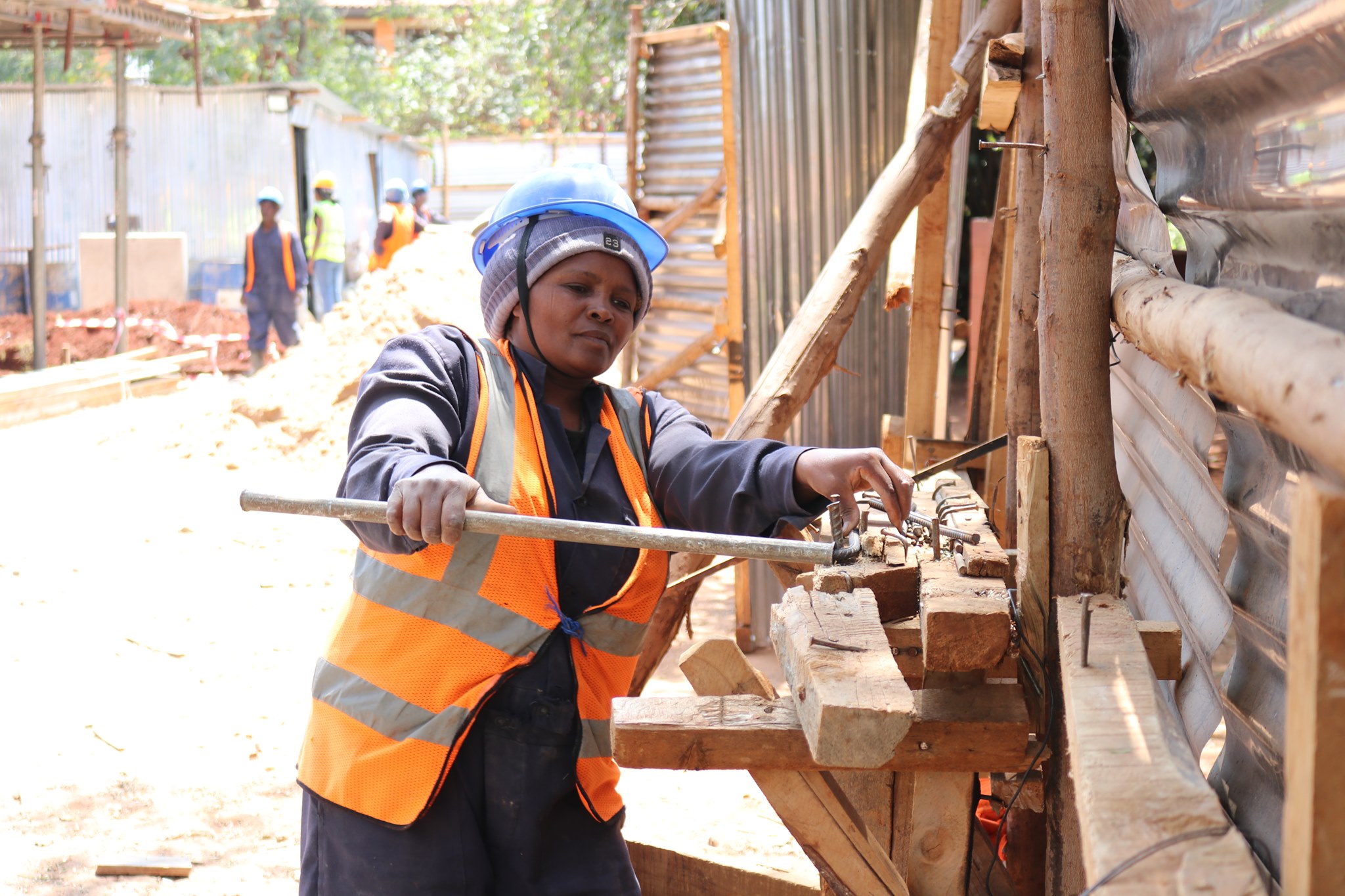
![]()
In Kenya, women are significantly disadvantaged socially and economically, with over half the female population living below $3.10/day. Nationally, unemployment has decreased in recent years but among youth (15-35yrs.), the rate is 22% (ILO, 2016) on average and varies by gender and living location, with young women in urban areas ranking most likely to be unemployed (UKAID, 2017).
Meanwhile, construction is one of the fastest-growing sectors on the African continent, but one of the least gender inclusive. The construction industry is booming due to high levels of population growth, urbanization, and increasing demand for affordable housing. In Kenya, demand for housing alone is growing at a rate of 200,000 units/yr. and the existing construction labour force can only supply 50,000 units/yr, indicating huge job creation potential for skilled and semi-skilled individuals (Kenyan National Housing Corporation, 2019). Yet, women are largely excluded from this high-potential industry and thus the market opportunity to secure employment and income, which decreases the prospects for closing the national gender gaps in unemployment and poverty. Kenya’s construction industry employs less than 3% women, which is below the already low global standard (no country engages more than 15% women in construction) (NCA, 2018).
![]()
Our Approach
Founded in 2018, Buildher is donor funded project whose mission is to empower women through construction. Buildher equips disadvantaged young women from Nairobi’s informal settlements with accredited construction skills, leading to greater financial prosperity while promoting gender equality within the construction industry. Buildher also conducts advocacy to address the systemic barriers keeping women from viable employment and provide resources for the industry to be more inclusive to women and youth.
To be eligible to apply to Buildher, the women must meet the below characteristics:
![]()
Buildher prepares women for jobs in the construction industry through a rigorous 12-month training to employment program that focuses on four pillars:
A. Accredited Construction Skills Training,
B. Life Skills Development,
C. Women & Family Support and
D. Advocacy.
Buildher’s 12-month vocational training program comprises a four-month workshop component and eight-month employment training component which prepares women for careers in a male-dominated sector while supplying employers with high-quality talent. Buildher’s approach addresses the socio-economic barriers keeping women from accessing vocational training opportunities in the first place. The approach further seeks to bridge soft-skill gaps created by historic inequities to promote professional success and ensures that employers have female-friendly workplace practices and policies.
Key Results
Buildher has achieved the following key results since 2019.
- Buildher trained 194+ women in life skills and Carpentry & Joinery technical skills
- 65% Employment placement rate – This is the rate of absorption of women into new jobs in the construction sector (Pre-Covid). In 2021, Buildher plans to place an additional 200+ women into new skilled construction sector jobs.
- 67% Increase in productivity – This is the average increase in productivity that employers are reporting, both at workshops and construction sites.
- 70% Employers changed/developed policies that allow for integration of women – This is the proportion of Buildher’s employment partners that have enacted policies and protections on gender & sexual harassment, dignified pay and health and safety to enable women integration in the sector.
![]()
Lessons Learnt (Success Factors & Challenges)
- Buildher has developed additional internal processes to monitor the development of trainees and capture feedback from employers, as well as the establishment of new partnerships to help deliver training and capacity building support in specialized areas.
- To remain relevant to the needs of the industry, Buildher maintains continuous feedback loop between itself and industry stakeholders to ensure that the program always responds to industry needs.
- Continuous sharing of lessons learnt across sectors and programs can helps Buildher to create an acceptable and impactful program.
- Stipend loans – We found that these can be counterproductive in the long run. Buildher ran the risk of having recruits joining the program to enjoy this service, then drop out when the service came to an end. We have in 2021 stopped all stipend payments to trainees.
- Self-sponsorship for examination fees as part of trainees putting their skin-in-the-game – this has so far been effective. We have had zero attrition of trainees since January. Previously, we would have 10% of trainees dropping out of the program by month 2.
Challenges & Mitigation
- Trainee attrition has been a challenge. Buildher is exploring the creation of a package for women to co-fund their education as a commitment to the program.
- Women’s health and wellbeing affect their productivity – Buildher has set up programs for building physical and mental strength and resilience.
Moving forward
Women represent just 1.5% of skilled labour (NCA) and Buildher’s target is to increase this share to 10%. BuildHer further seeks to achieve the following:
- Demonstrate viability and scalability of each training area and prove an ability to meet market needs and demands.
- Scale to serve 600+ construction and fabrication sector employer partners.
- Support 60% of employer partners to change policies to incorporate gender, sexual harassment and dignified pay.
- 80% of women trained transition into long-term employment in construction, fabrication and related industries.
- Support 400+ Buildher alumni to develop sustainable business ventures and strategies in fabrication and construction in the next two years.
![]()
![]()
Resources
https://www.youtube.com/channel/UCrYI0O_D2DAEOs5_vV9fVxQ/videos


